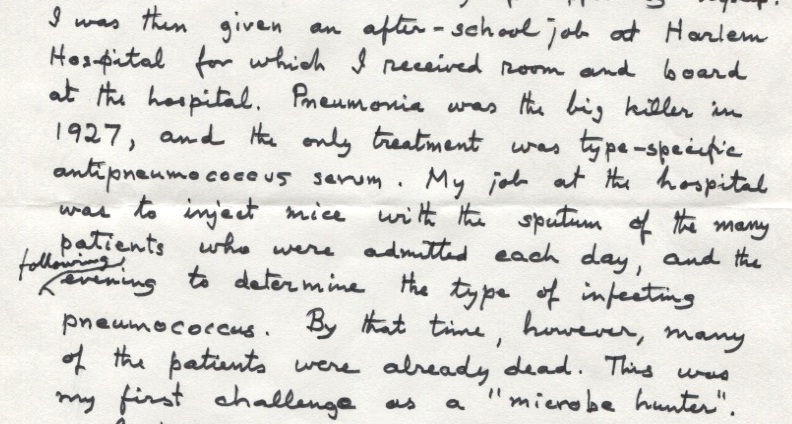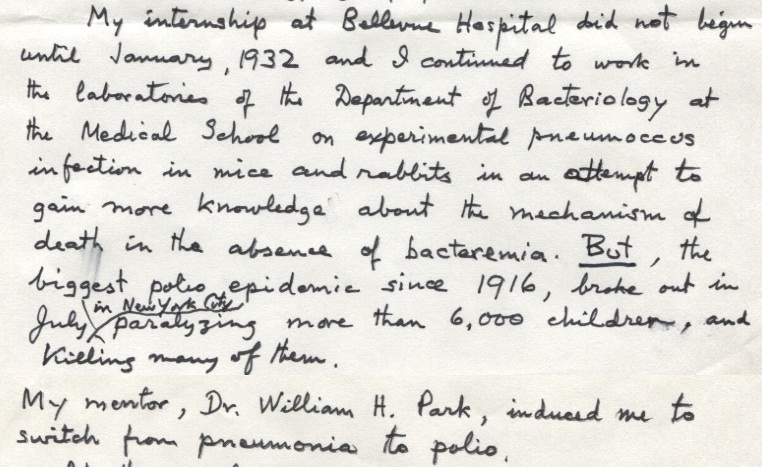By Jeff O’Flynn, Sabin Project Student Assistant
[Sabin Archivist’s Note: This week features the first blog post on the Sabin project from Jeff O’Flynn, one of our new student assistants. Jeff is pursuing a doctoral degree from the University of Cincinnati College-Conservatory of Music. He will be blogging on different Sabin-related topics as we work on the project. Please give Jeff a warm welcome by reading his posts! -SB]
The first assignment I handled when I started at the Sabin Archive nearly a month ago was to inventory a recent acquisition. Mrs. Sabin and her son sent us another large shipment of documents, photographs, awards, videos, and almost everything else imaginable. Sifting through these items served as my introduction to Albert B. Sabin’s life and legacy. This donation offered insight mainly into his later years and his posthumous honors with nearly all the items dating from 1970 forward. I learned many interesting things as I sorted through hundreds of fascinating items and I will share some of the most memorable items on this blog. First, I want to highlight an essay Dr. Sabin wrote in 1992 as an introduction to Paul de Kruif’s “Microbe Hunters” which influenced his life greatly.
Written ca. 1992, Dr. Sabin’s essay offers an autobiographical glimpse into his formative years. He mentioned many times that “Microbe Hunters” affected his career path. This essay describes its influence and, of even greater interest, his first forays into scientific experimentation.
Dr. Sabin first moved to New York City to study dentistry where he lived with his uncle, Dr. Sigmund Sidney, who sponsored his education. Dr. Sidney stipulated that young Sabin join his dental practice upon graduation but his nephew was feeling the pull of a different branch of medicine. After studying for three years, including a course called Bacteriology, Dr. Sabin read a first edition of “Microbe Hunters” (1926) that convinced him to “spend [his] whole life as a microbe hunter”. He moved away from his uncle’s house and patronage and began medical school as well as his own research.
Sabin was generously given a small area at the Bureau of Laboratories of New York City where he could pursue his own research concurrent with his medical studies. He closely observed the department’s staff while doing his work and thus was afforded an extra benefit. He also worked at Harlem Hospital where he encountered his “first challenge as a ‘microbe hunter’”. When he started, “pneumonia was the big killer” and Sabin was responsible for determining which type of pneumonia each patient had contracted. He quickly discovered that patients died before he could complete the 24-hour test. Tasked with quickly identifying the strain, Sabin developed a rapid 3-hour test that his mentor named in his honor. This was his first victory as a microbe hunter and the discovery became well known. In this essay, Dr. Sabin notes that the following question appeared on his examination for a license to practice medicine in the State of New York: Describe the Sabin method of rapid typing of pneumococci. You can imagine Dr. Sabin, recently graduated from New York University, had a satisfactory answer for that!
Then, before Dr. Sabin began his internship, a polio outbreak devastated New York City leaving more than 6,000 children paralyzed or dead. His mentor, Dr. William H. Park, convinced Dr. Sabin to change his focus to polio and thus the seeds were planted for his most famous research. After accepting a position at the Children’s Hospital Research Foundation of the University of Cincinnati, he briefly describes his war on polio through the oral polio vaccine he developed. In the closing, he writes: “It is 67 years ago that Paul de Kruif’s ‘Microbe Hunters’ started my career, and I remain deeply indebted to the book he wrote.”
This essay gives us a first-hand perspective on Dr. Sabin’s formative years and motivations and is an interesting read. If you want to read the entire story, feel free to contact us at the Hauck Center for the Albert B. Sabin Archives at chhp@uc.edu.
In 2010, the University of Cincinnati Libraries received a $314,258 grant from the National Endowment for the Humanities (NEH) to digitize the correspondence and photographs of Dr. Albert B. Sabin. This digitization project has been designated a NEH “We the People” project, an initiative to encourage and strengthen the teaching, study, and understanding of American history and culture through the support of projects that explore significant events and themes in our nation’s history and culture and that advance knowledge of the principles that define America. Any views, findings, conclusions, or recommendations expressed in this blog do not necessarily reflect those of the National Endowment for the Humanities.



